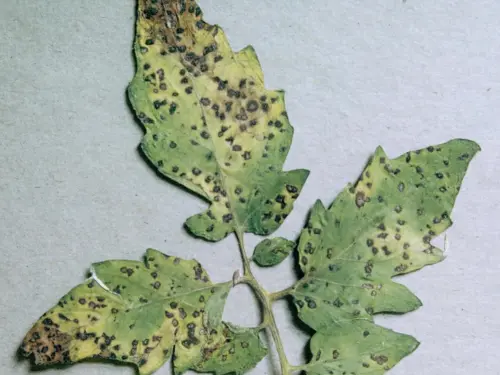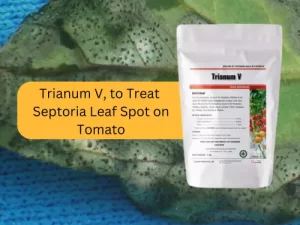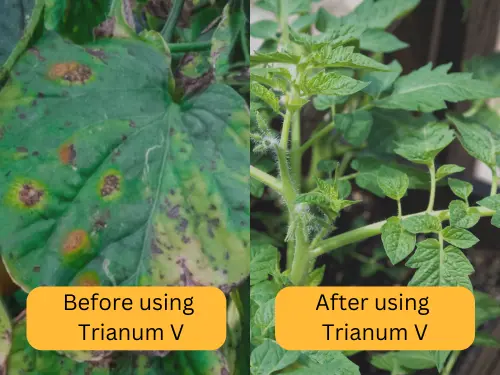Septoria leaf spot tomato is a global fungal disease that severely affects tomato plants. To manage septoria leaf spot on tomatoes, employ crop rotation, and remove diseased leaves. Septoria leaf spot treatment involves organic fungicides like copper or baking soda solutions. Septoria leaf spot organic treatment includes avoiding wet leaves to prevent fungal growth. Best fungicide for septoria leaf spot combines copper formulations with good cultural practices. Septoria leaf spot of tomato symptoms include yellowing leaves and distinct brown-edged spots. Use organic fungicide for septoria leaf spot, and ensure dry conditions to halt spore spread.
Continue reading to understand more about septoria leaf spot organic treatments.

The fungus enters tomato plants through leaf stomata or directly into epidermal cells. Septoria leaf spot of tomato symptoms appear as circular lesions on older foliage. Lesions are 2-5 millimeters, with a gray center, brown edges, and visible pycnidia. As the disease progresses, leaves brown, yellow, and fall, diminishing the plant’s sunlight absorption and health.
The life cycle of Septoria lycopersici is tightly linked to its environment and strategies for survival. The disease thrives at 20-25°C, in warm, moist conditions. It persists on tomato debris and solanaceous weeds all season. Water splashes, wind, insects, and tools mainly spread the fungal spores. Its winter survival underscores the need for clean conditions and disease control.
Other diseases related to tomatoes are powdery mildew, fusarium wilt, early blight, spider mites, and aphids. Click on the links to learn more!
In the management of diseases like Septoria tomato leaf spots, a thorough knowledge of biological as well as chemical control techniques is vital for a successful disease management. Utilizing organic fungicide for septoria leaf spot or synthetic is a key element for this integrated pest management (IPM) approach. Their effectiveness depends on the timing of application and alignment with the cycle of disease and the current environmental conditions.
For traditional farmers, a myriad of chemical fungicides provide a strong protection from Septoria leaves. Chlorothalonil (Bravo), mancozeb (Penncozeb), and azoxystrobin (Quadris) are active ingredients to halt disease spread. Applied preventatively, these fungicides significantly lower the risk of Septoria-caused leaf spots.
However, organic farmers have enough challenges with fungicides because of the limitations in organic farm inputs.
The use of biological control techniques, leveraging the antagonistic nature of organisms, provide a long-lasting basis for disease management strategies. One of the accurate examples uses Trichoderma Harzianum, an incredibly beneficial fungus, which is well-known for its ability to fight pathogenic fungi like those that cause Septoria leaves spot. Products such as Novobac’s Trianum-V, the best fungicide for septoria leaf spot. It contains T. Harzianum as the active ingredient, demonstrate the advantages of biological control in the field of agriculture.

Trianum-V is a natural solution to fight the widespread menace that is Septoria leaf spot tomato, using the potential of Trichoderma Harzianum. The organic fungicide for septoria leaf spot that is natural and non-toxic is crucial for growers looking to protect their crops from these and other fungal enemies without using synthetic chemicals.
Trichoderma harzianum upon application, is the pioneer of a powerful defense mechanism in plants via the systemic acquired resistance (SAR) and the induced systemsic resistance (ISR). The beneficial fungus fends off harmful pathogens to gain vital space and nutrients in the plant, and establishes its own preemptive defense. It functions as a formidable mycoparasite by deploying enzymes to break down the structure of pathogenic fungi. Furthermore, it enhances the plant’s defense by increasing creation of defense substances like phytoalexins, PR protein and other. This double action of preemptive colonization as well as defense fortification gives plants an effective shield against the spread of diseases.
Trianum-V (best fungicide for septoria leaf spot) is a key component in the arsenal of Septoria leaf spot. It provides organic farmers a sustainable and sustainable option to protect their crop. Through using this natural fungicide as part of an overall integrated approach to managing disease, farmers are able to definitely deal with the challenges presented by fungal diseases and still adhere to the organic principles.

The primary reason for tackling Septoria leaf spot on tomatoes is the IDM method, which combines biological, cultural and chemical strategies. Monitoring the health of crops and environmental conditions closely allows the prompt application for septoria leaf spot treatment prior to the onset of disease. Forecasting models for disease could be an integral part of this approach, providing information on the times when disease pressure will likely increase and thereby maximizing the timing of application of fungicides and other septoria leaf spot organic treatments.
In conclusion, managing Septoria leavespot in tomatoes requires a multi-faceted approach. Products like Trianum-V, with Trichoderma Harzianum, enhance integrated disease management (IDM) by using biological control. Combined with careful chemical fungicide use and strong cultivation practices, growers actively suppress disease and protect their crops.
As a plantation owner, I face quite a few..
The banana weevil, also known as Cosmopolites sordidus, is..
Fusarium wilt in banana is usually known to be..

Leave a Reply